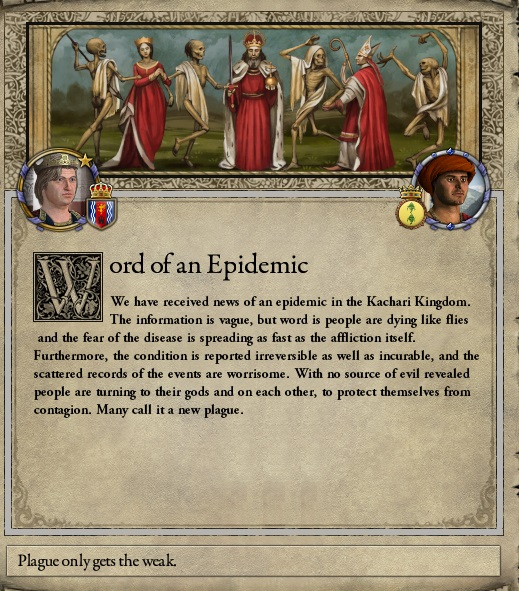All caught up again.  Followed the career of The Bear from its beginning to his triumph in India. The Assyrian-Nestorian angle is indeed an interesting one.
Followed the career of The Bear from its beginning to his triumph in India. The Assyrian-Nestorian angle is indeed an interesting one.

Nahir on the other hand, was a tortured titan.
Wow - you certainly benefited from whatever short circuited that event chain, gaining a useable Boss++ character into the bargain.Nahir the Bear is a very interesting character - as you can probably tell from his frankly ridiculous stats
He may be as mad as a cut snake in some respects, but this was a very wise choice.Reluctant to send his realm into civil war, Nahir renounced the Cosmasians and returned to the formal services of the Church for the first time in decades – securing his peaceful ascension.
Aha, a nice little teaser.As the realm appeared to be approaching its first period of peace in a generation, an emissary from the distant St Thomas Christians southern India’s Malabar Coast arrived in Nineveh, fellow Nestorians, with a plea for help.
And so it proved - looks like maybe terrain, a big cavalry advantage and the Bear’s extraordinary military genius must have come into play there for the victory against the odds.At the decisive battle of the war at Isdhoo, the superiority of Assyrian arms was made clear for all to see as, despite a significant numerical advantage, the Cholans were heavily beaten by Nehor and send into a disorderly retreat.
An important lodgement. Maybe the Raja will try some expansion of his own, though it could also get him into trouble and drag Assyria back in. Or provide a firm base for expansion, perhaps by a successor.creating the Raj of Malabar, a Christian state on the subcontinent’s southwestern shore and the Maldives that swore allegiance to Nineveh but enjoyed a high degree of functional autonomy.
Good reason then - thanks for the additional in-game insight.One of the Nestorian holy sites is in southern India - the others being Edessa, Jerusalem, Baghdad and Merv in eastern Persia. With just 2 under my control Nestorian moral authority was challengingly low for me to actually spread the faith within my own realm
One suspects the only quiet he will see is once he shuffles off the mortal coil! Use him or lose him.Nehor has managed some incredible feats. Leading the Assyrian armies while under his brother's rule to defeat the Jihadi invasions, conquering all of Mesopotamia and now leading a remarkable Crusade to India. He's into his sixties now - we shall see if he will go into a quiet retirement or has more ambitions left to fulfil.
- 2













